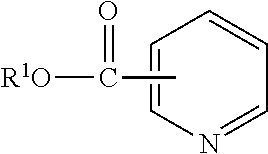Lubricant compositions containing a heteroaromatic compound
a technology of heteroaromatic compound and lubricant composition, which is applied in the field of lubricant compositions, can solve the problems of poor seal protection performance, achieve the effects of boosting the total base number, maintaining the seal compatibility of the lubricant composition, and boosting the tbn
- Summary
- Abstract
- Description
- Claims
- Application Information
AI Technical Summary
Benefits of technology
Problems solved by technology
Method used
Image
Examples
example 1
Preparation of Butyl Nicotinate Using Sulfuric Acid Catalyst
[0084]Nicotinic Acid (3.0 g, 24.4 mmol) and n-butanol (9.0 g, 122 mmol) were mixed together at room temperature in a 2-neck 25 mL round bottom flask equipped with a magnetic stir bar and reflux condenser under an atmosphere of N2. Sulfuric acid (3.59 g, 36.6 mmol) was added dropwise to the flask over a period of 30 min. Once the addition was complete, the reaction mixture was heated to 85° C. and held for 2 hours. The reaction mixture was allowed to cool and poured over ice. The resulting solution was neutralized with K2CO3 and extracted with EtOAc (2×75 mL). The organic layer was dried over MgSO4, filtered, and concentrated to yield a light yellow liquid. 1H NMR (500 MHz, CDCl3): 9.229 ppm (s), 8.774 ppm (d), 8.305 (d), 7.391 (t), 4.369 (t), 1.762 (m), 1.484 (m), 0.991 (t). IR: 2956.6, 1719.5, 1590.8, and 705.1 cm−1.
example 2
Preparation of Butyl Nicotinate Using Recyclable Alkylbenzene Sulfonic Acid Catalyst
[0085]Nicotinic Acid (24.6 g, 0.2 mol), n-butanol (100.0 g, 1.33 mol) and heptane (20.1 g) were charged to a 500 mL reaction kettle and equipped with mechanical stir, a Dean-Stark trap, and thermocouple. The mixture was stirred at 300 rpm under nitrogen atmosphere and alkylbenzenesulfonic acid (480 mw, 120 g, 0.25 mol) was added dropwise through an addition funnel over 2 hours. The mixture was heated to 115° C. and held for 3 hours. A second portion of Nicotinic Acid (24.6 g, 0.2 mol) was added through a powder funnel and the temperature was increased to 150° C. and vacuum was applied to −29.5 in Hg and held for 1 hour. The distillate was then taken and solvents removed under vacuum on a rotary evaporator to yield the desired product. This process was repeated 2 additional times using the same Alkylbenzenesulfonic acid.
example 3
Preparation of Butyl Nicotinate in a Pressure Reactor
[0086]n-Butanol (177.6 g, 2.4 mol), nicotinic Acid (98.4 g, 0.8 mol) and toluene (45.0 g) were charged to a 450 ml pressure reactor kettle and equipped with mechanical stir, a pressure take-out trap, and a thermocouple. The reactor was sparged with nitrogen and heated to 116° C., sealed, then heated to 200° C. and held for 6 hours. The mixture was then removed from the reaction kettle and volatiles removed under vacuum on a rotary evaporator at 60° C. The product was then purified by combining it with 50.0 g toluene and 60.1 g 4.4% NaOH solution in a 500 mL separatory funnel. The organic layer was then separated, dried over 5 g MgSO4 and solvents removed under vacuum on a rotary evaporator at 60° C. to yield the desired product.
PUM
| Property | Measurement | Unit |
|---|---|---|
| Fraction | aaaaa | aaaaa |
| Percent by mass | aaaaa | aaaaa |
| Percent by mass | aaaaa | aaaaa |
Abstract
Description
Claims
Application Information
 Login to View More
Login to View More - R&D
- Intellectual Property
- Life Sciences
- Materials
- Tech Scout
- Unparalleled Data Quality
- Higher Quality Content
- 60% Fewer Hallucinations
Browse by: Latest US Patents, China's latest patents, Technical Efficacy Thesaurus, Application Domain, Technology Topic, Popular Technical Reports.
© 2025 PatSnap. All rights reserved.Legal|Privacy policy|Modern Slavery Act Transparency Statement|Sitemap|About US| Contact US: help@patsnap.com



